Are you a Quiet Speculation member?
If not, now is a perfect time to join up! Our powerful tools, breaking-news analysis, and exclusive Discord channel will make sure you stay up to date and ahead of the curve.
Welcome back readers and fellow speculators! Today I hope to begin a new article series designed around the idea that while some cards seem like obvious picks, it's important to not just follow the pack and to invest in only what you truly believe in (MTG cards, stocks, bonds, etc.). With that idea in mind, my goal is to challenge you all to possibly rethink your picks and to hopefully find any inherent biases you might have towards certain cards or types of cards. Without further ado, let's begin.
Khans Fetchlands
This one seems so obvious as a speculation target. After all, before reprinting, Polluted Deltas sat at $80-90 and Flooded Strands were $60-70. So surely the Khans ones will grow to be much higher than current prices--except the original ones reached those prices because there were so few of them in supply and the demand had grown rapidly since their printings. More recently, Magic player growth seems to have slowed down dramatically (if not dropping a bit) so why would the price continue to rise?
Currently they are legal in every major format and their prices sit between $8-$15. Without an increase in player base, the demand will drop at rotation as the Standard-only players will no longer need them. The best comparison for the future price of these is to look at the Return to Ravnica shocklands, which despite many expectations, have barely budged after rotating.
My biggest concern here is that even the current price is heavily driven by speculation, which is a form of artificial demand, and means that when some of those speculators get cold feet (or need to free up capital) the supply will increase but the demand won't leading to a drop in prices.
A good comparison is the US housing market, pre-2007, when everyone buying houses assumed they were a safe bet (thanks to AAA ratings by Standard and Poor's, Moody's, and other rating agencies); this led home buyers and house flippers to assume real-estate was one of the safest bets they could make (we've since discovered that almost all the rating agencies were off by a factor of 500-20,000).
If that sounds familiar it's because it's one of the rules of thumb that I (and other vocal MTG speculators) have touted for quite a while: bet on lands because they are typically the most needed cards. However, consider if we reach a Standard format in which one color combination is so dominant that a large majority of the decks in any given format are this color combination only (Caw-Blade is a good example). In that format, the lands of those color combinations would be valuable, but all other lands would not.
It's also important to keep in mind that in these situations one can only have four of the non-basic color fixing lands which is the same max number of any key cards for the deck. In this situation the maximum value of the land may be dependent on what other cards are needed for the deck.
Abrupt Decay

Here's a card that is safe from a MM2015 reprint and sees a lot of play in Modern. Its strength is heavily tied to how good black and green are in the format. Blood Moon usage is on the rise because of how much it shuts off a lot of decks and Abrupt Decay is very difficult to cast through a Blood Moon, especially given that the top mana dork in Modern (Noble Hierarch) can't tap for black.
We're also seeing a rise in Tron decks, which are largely immune to Abrupt Decay (by which I mean any viable targets aren't high value) with the release of Ugin, the Spirit Dragon. Due to its uncounterability, the decks that are most weak to Abrupt Decay (mainly Splinter Twin) are adopting other ways around it, namely giving the target hexproof, indestructibility, or protection from black or green. Abrupt Decay can also be swerved to Spellskites, which are seeing a lot of play right now.
Scavenging Ooze
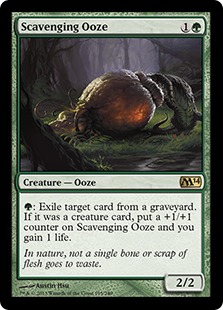
This card is typically the bane of graveyard based strategies in Modern. However, its biggest flaw is that its ability typically gets worse after the first one is in play. Because of this they don't typically get played as a full playset, which limits the demand; my research shows they typically show up as a two- or three-of.
While it was printed in a core set, which would normally limit the number of copies in the supply, being given away as a promo and previously being printed in Commander means there are considerably more copies in supply than one might originally expect. This was a $40 card at one point, prior to its reprinting, but the reduction in Maverick decks in Legacy means that demand from that format has drastically decreased.
It has found a home in several Modern decks, however it's been in these archetypes since its release and its price has remained stagnant since it left Standard.
Chord of Calling
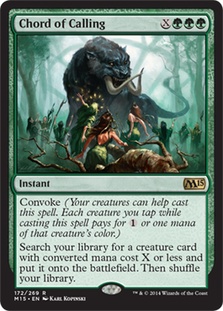
A card that was $40 and is now available for $3.50. What a slam dunk, right? Except the deck that drove its price up had its key component banned (Birthing Pod). Many thought the deck could survive this banning, but while tutoring up bullets is a very powerful effect, this card can not get both components of a combo as Birthing Pod could.
Green-based decks in Modern seem to be shifting away from creature combo decks and more towards cheap/value creatures, so the need to waste deck space on tutors when one could simply play additional powerful threats isn't necessary. The triple green requirement is also somewhat steep in a format dominated by two- and three-drops.
Dragonspeaker Shaman
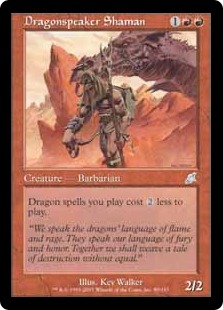
Here we have a casual card that has maintained a pretty impressive price despite two reprints. However, this one is entirely based on the casual market. Any sort of new mass reprint (perhaps a Dragon-themed duel deck) would likely kill its value.
Both previous reprints were in relatively undesireable "sets" (Archenemy and Knights vs Dragons). Should WoTC throw it into any newer duel deck or specialty product its price would take a much larger hit, especially if said product included a desirable chase card that would cause players to buy it en masse and thus leave an abundance of the other cards in supply.
If you want a good comparison, look at Baleful Strix. This card once hit a high of slightly over $22, but with a reprint in another Commander deck (which had a chase rare, True-Name Nemesis) it plummeted and now both copies sit around $4-5. If a similar reprinting for Dragonspeaker occurs it will go from $6.5-$7 down to $1.5-$2.
Tasigur, the Golden Fang
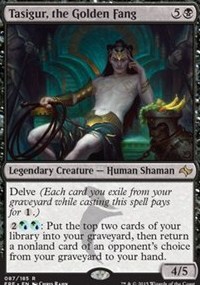
Here we have another Standard-legal card with lots of Eternal possibility. Tasigur requires either blue or green in the deck to be anything more than a slightly cheaper Tombstalker. The biggest downside is that you need to fill your graveyard relatively quickly to truly benefit from casting him early, but casting him early may limit the use of his ability.
His ability is also heavily reliant on manipulating your own graveyard and your opponents' decision making skills. If you can't control your graveyard efficiently then you're paying four mana to draw your weakest card. The fact that he can't return lands is both a boon and a bane. It means your opponent is forced to give you a spell of some sort (assuming you have one in your graveyard), but it also means that if you really need a land his ability is actually detrimental. Your opponent can also manipulate your graveyard to limit his usefulness and he has no evasion nor protection from removal spells.



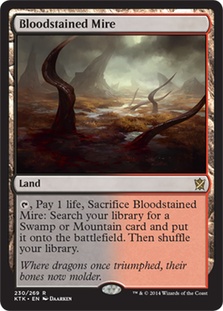
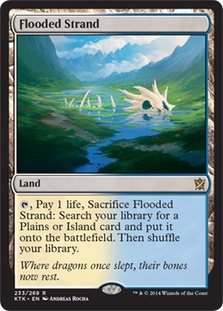
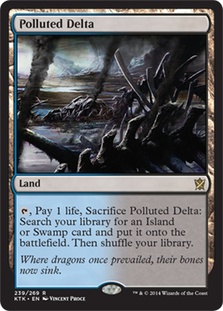
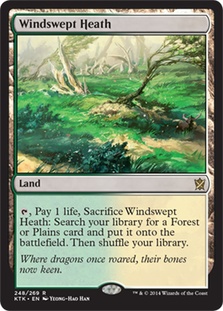
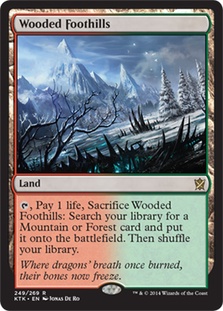



Player base growth has slowed. It is still growing, but at a much slower rate. I wouldn’t count on player base growth to drive up the prices of the above cards, but I do believe modern will continue to grow in popularity. The more affordable the format becomes, the more players it will acquire. Modern Masters set releases also drive up interest because the cards become more available.
As more people pick up modern, the mana bases will go up. I’m personally banking on more interest in Modern. But I’m not stockpiling fetchlands and shocklands because I expect to make a ton on them going up, they are a safe place to park money that will likely earn a very modest percent. It’s a good place to lock in profits.
Tasigur I personally feel is underplayed. I think they is absurdly good. I see more and more modern decks running 2 or even 3. I think some of the points you made are invalid. I’ve never said to myself “I wish my opponent would give me a land” when I already have 4 mana to activate his ability. Tarmogoyf doesn’t have any evasion or resilience to removal spells either. Even without any additional graveyard manipulation, getting any spell back is fine. Most of the time when I delve to cast him, I am able to remove all of the useless spells that I don’t want to get back. Tasigur is stagnating a bit right now because he is available in trade binders, but Fate Reforged was only the newest set for like 7 weeks and was very undervalued.
I should have mentioned that with the exception of Dragonspeaker Shaman…I have been speccing on ALL of the above mentioned cards. The point of the article though was to take a step back, understand one’s own bias’s and to critically review the cards from the opposing point of view. Too often we allow our internal bias’s to override flaws and then are surprised when our biased predictions turn out wrong (often because others DID notice the same flaws).
Aside from Dragonspeaker Shaman, I really like all of these as well. Great targets, and while the player base is not increasing at a slower rate, that could easily change.
MTG has always gone through ebbs and flows, but looking at the market on these cards from a Technical Analysis, these could appreciate, albeit at a slow rate.
Oops sorry edit: “while the player base *is increasing at a slower rate*”
I feel like the new PPTQ policy will help drive interest in Modern, more so than there already is.